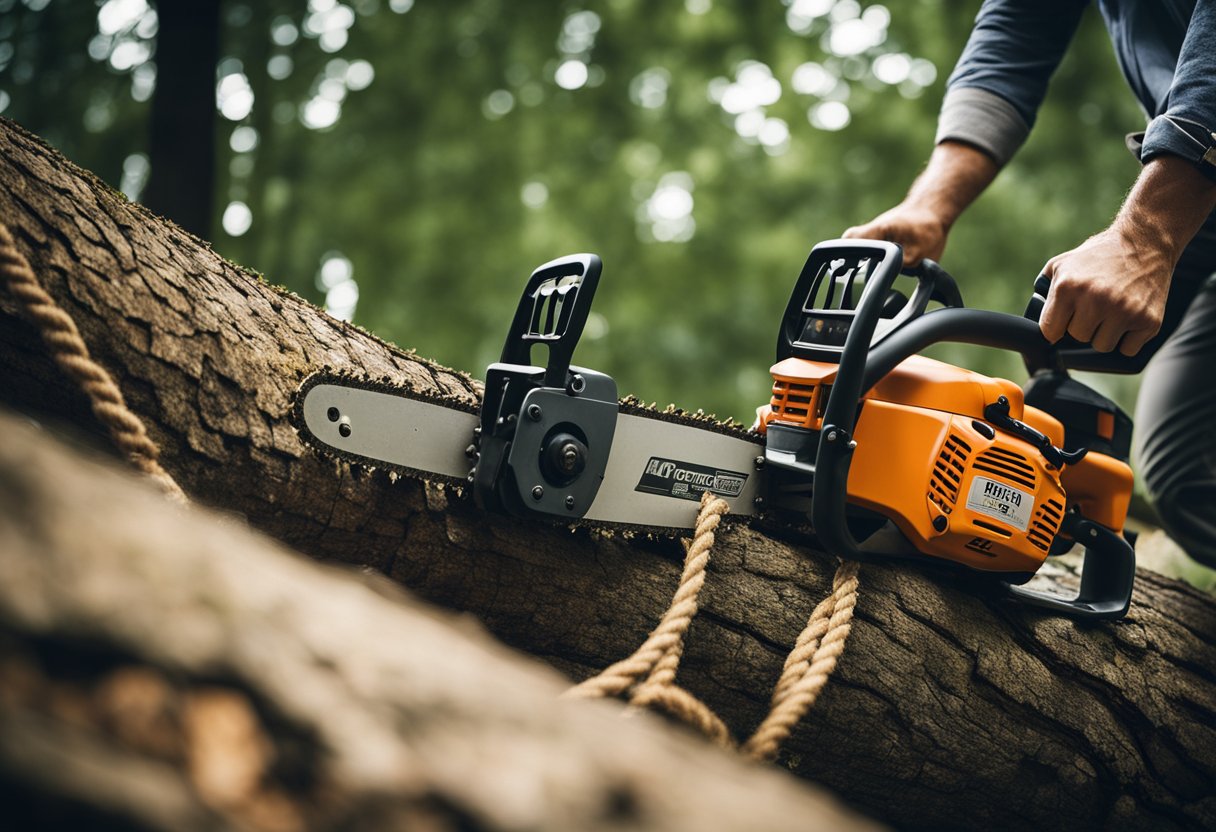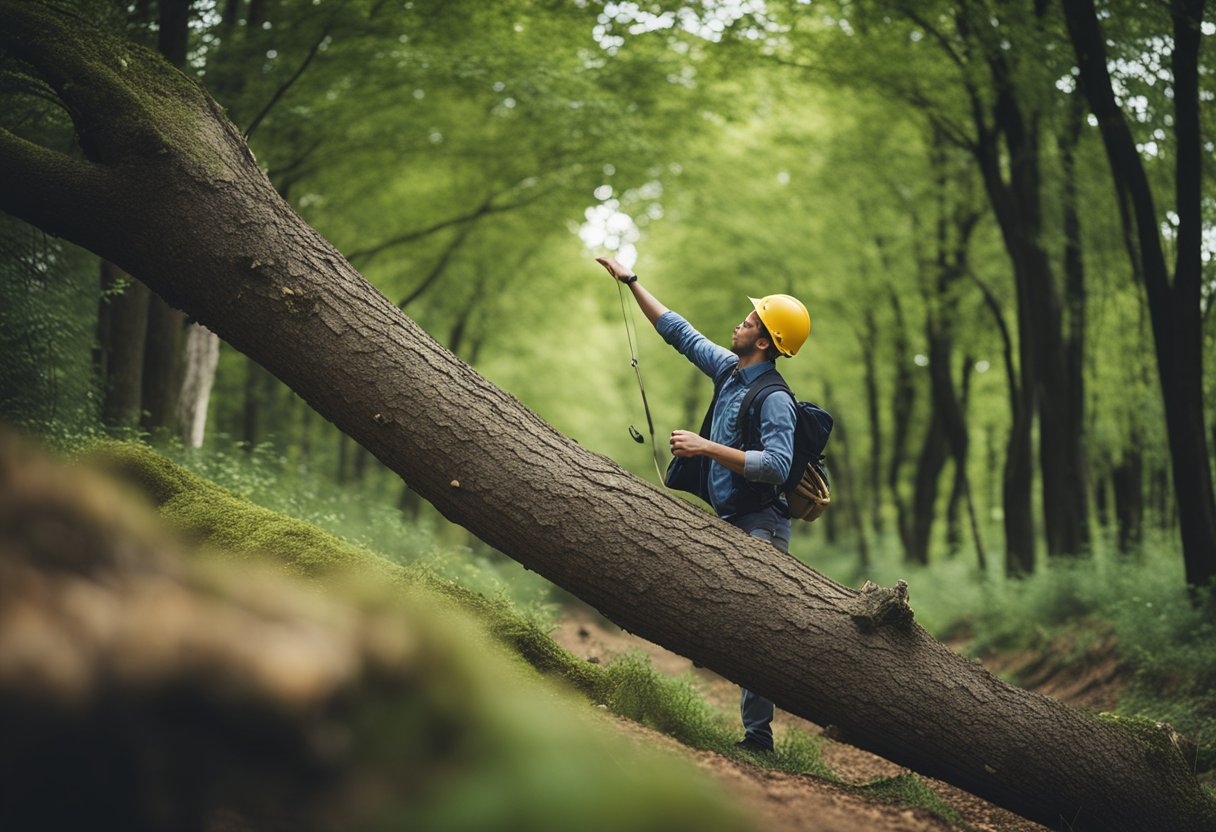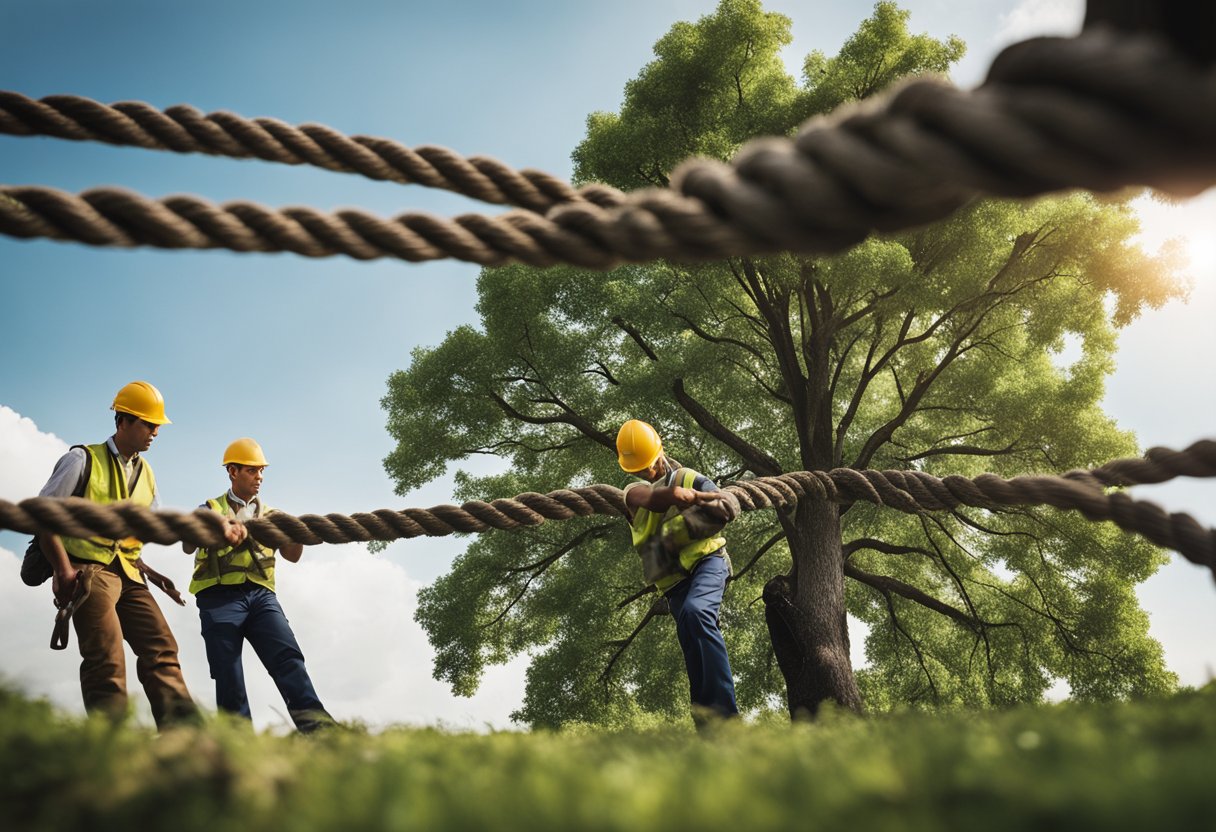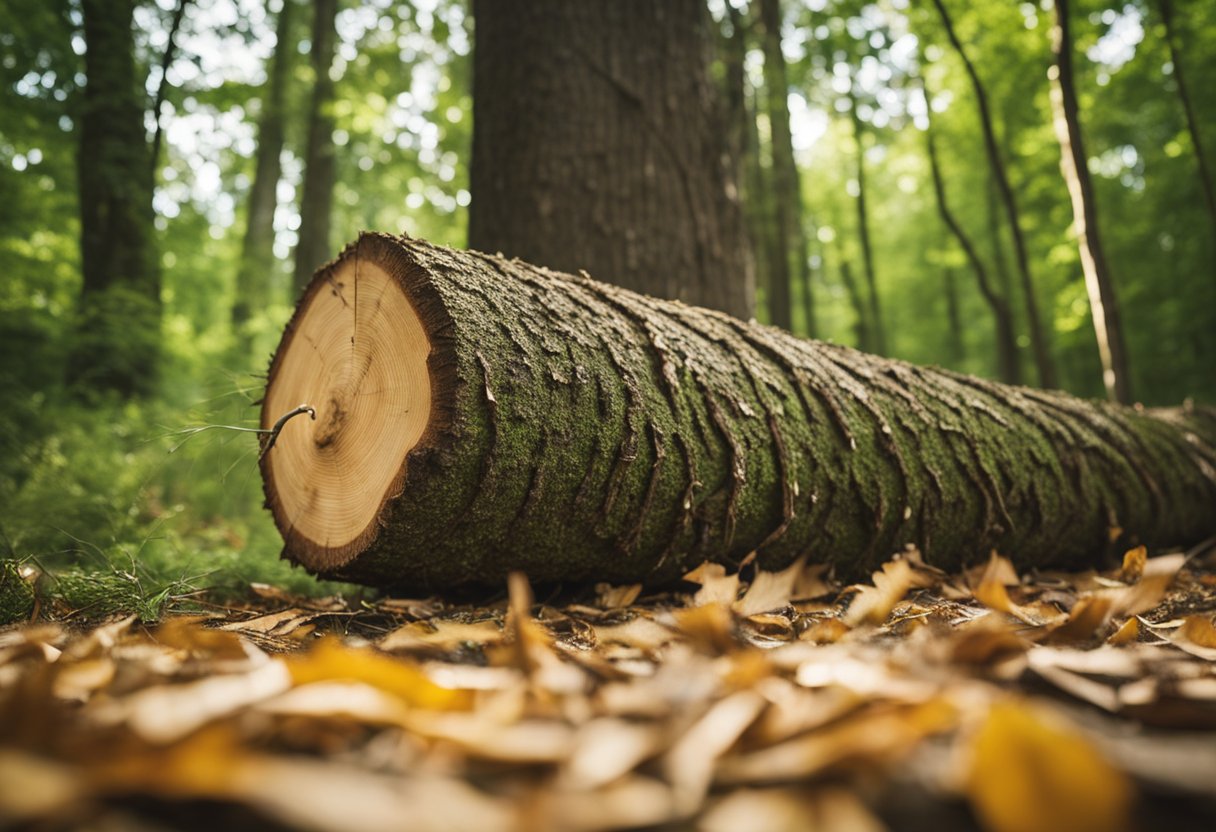Felling a tree is a task that requires careful planning and execution, especially when the tree is leaning in a particular direction. If not done correctly, it can lead to property damage, personal injury, or even death. In this article, I will share some tips on how to fell a leaning tree in the opposite direction safely and efficiently.
Understanding the basics of tree felling is crucial before attempting to fell a leaning tree. This includes assessing the situation, preparing for felling, and using the correct felling techniques. Safety measures should also be taken into consideration, such as wearing appropriate gear and ensuring that the area is clear of people and obstacles.
Key Takeaways
- Assess the situation and determine the direction of the lean before felling a tree.
- Use proper safety measures and equipment to ensure a safe felling process.
- Prepare for felling by using the correct techniques and ensuring that the area is clear of people and obstacles.
Understanding the Basics
https://www.youtube.com/watch?v=PTUreUjGBsw&embed=true
Before we start discussing how to fell a leaning tree in the opposite direction, let’s first understand some basics of trees and how they grow.
A tree is a vascular plant that has roots, a trunk, branches, leaves, and grows by a process called photosynthesis. Trees vary in size and shape, and some trees grow taller and wider than others. When a tree leans in a particular direction, it means that the weight of the tree is not evenly distributed, and it is putting more pressure on one side than the other.
Felling a tree means cutting it down, and it requires some planning and preparation. When felling a tree, it is essential to ensure that it falls in the desired direction to avoid causing damage to nearby structures or people. When a tree is leaning in the opposite direction, it requires some additional steps to ensure that it falls in the desired direction.
To fell a leaning tree in the opposite direction, you need to follow some basic steps. First, you need to assess the situation to determine the back lean of the tree. Next, you need to place ropes and ground anchor pins to secure the tree. Then, you need to initiate the cutting by making the face cut and the back cut. Finally, you need to pull the tree in the opposite direction using the ropes to make it fall safely.
In summary, felling a tree requires some planning and preparation, and when a tree is leaning in the opposite direction, it requires some additional steps to ensure that it falls in the desired direction. Understanding the basics of trees and how they grow is essential to safely fell a tree.
Assessing the Situation
Before felling a leaning tree in the opposite direction, it is crucial to assess the situation to determine the safest and most effective approach. Several factors must be considered when assessing the situation, including the direction of the lean, the back lean, the offset center of gravity, the pivot point, the apex point, the surrounding yard, fence, power lines, and any potential risks.
First, I identify the direction of the lean by standing behind the tree and looking up at the trunk. This step is essential because it helps me determine where the tree is likely to fall and what obstacles it might encounter. If the tree is leaning towards a structure or power lines, I take extra precautions to avoid any damage.
Next, I determine the back lean, which is the opposite direction of the lean. This step is crucial because it helps me plan the felling direction of the tree. I also measure the diameter of the trunk and use a tree weight calculator to estimate the weight of the tree.
I also locate the offset center of gravity, which is the point where the tree’s weight is not evenly distributed. This point is usually located on the opposite side of the lean. I use this information to determine the pivot point, which is the point where the tree will pivot and fall once it is cut.
Additionally, I locate the apex point, which is the highest point of the tree. This point is essential because it helps me determine the direction in which the tree should fall. I make sure that the tree is felled in the opposite direction of the lean, and the apex point is directed towards the desired felling direction.
Finally, I assess the surrounding yard, fence, and power lines to ensure that they are not in the felling path. I also consider any potential risks, such as weather conditions and wind, which may affect the felling direction of the tree.
By carefully assessing the situation, I am confident in my ability to fell a leaning tree in the opposite direction safely and effectively.
Safety Measures
https://www.youtube.com/watch?v=HBw_JQHr1S4&embed=true
When felling a leaning tree, safety should be your top priority. Always wear the appropriate safety gear, including gloves, a hard hat, safety glasses, and steel-toed boots. This protective gear will help keep you safe from falling branches, flying debris, and other hazards.
Before you begin cutting, make sure you have a clear escape route in case the tree falls in an unexpected direction. Plan your escape route ahead of time and make sure it is clear of any obstacles.
When using a chainsaw, always follow proper chainsaw safety procedures. Keep both hands on the chainsaw at all times and never cut above shoulder height. Make sure the chainsaw is properly maintained and sharpened before use.
When felling a leaning tree, it is important to have a clear plan in place. Cut a V-shaped notch in the trunk on the side of the tree where you want it to fall. This will help guide the tree in the right direction. Secure ropes to the tree and pull down on them until the tree falls in the opposite direction.
Finally, use common sense when felling a leaning tree. If you are unsure about the safety of a particular cut or technique, stop and reassess the situation before proceeding. By following these safety tips, you can fell a leaning tree in the opposite direction safely and efficiently.
Preparation for Felling
Before felling a leaning tree, it is important to take the necessary precautions to ensure a safe and successful operation. Here are some steps to follow:
Assess the situation
First, assess the tree’s lean and determine the direction in which you want it to fall. Use a measuring tape to measure the height and diameter of the tree. This information will help you determine the amount of force needed to fell the tree and the size of the wedge-shaped piece that you will need to cut.
Choose the right tools
Choose the right tools for the job. A chainsaw is the most common tool used for felling trees. Make sure it is in good working condition and has a sharp chain. If you prefer to use a saw or an ax, make sure they are sharp and in good condition.
Secure the area
Clear the area around the tree of any obstacles, including rocks, stumps, and other trees. If the tree is near a building or other structure, take extra precautions to ensure that it falls in the right direction. Use felling wedges or drive wedges to control the direction of the fall.
Use rigging ropes and ground anchor pins
Use rigging ropes and ground anchor pins to secure the tree and prevent it from falling in the wrong direction. Stakes can also be used to anchor the ropes.
Use a tripod ladder or extension ladder
Use a tripod ladder or extension ladder to access the higher parts of the tree. This will allow you to cut branches and limbs that are causing the tree to lean.
By following these steps, you can safely and successfully fell a leaning tree in the opposite direction. If you are not experienced in felling trees, it is recommended that you hire a professional arborist to do the job for you.
Felling Techniques
https://www.youtube.com/watch?v=XxfHpSfIKRs&embed=true
When felling a leaning tree in the opposite direction, certain techniques need to be employed to ensure safety and accuracy. The following methods can be used to fell a leaning tree in the opposite direction:
Notch Cut
The first step is to make a notch cut on the side of the tree that is facing the direction of fall. This notch cut should be made at a 90-degree angle to the direction of fall and should be about one-third of the diameter of the tree. The notch cut should be made with a chainsaw bar and should be deep enough to create a hinge.
Undercut
The next step is to make an undercut on the opposite side of the tree. This undercut should be made at a 45-degree angle to the direction of fall and should be slightly above the notch cut. The undercut should be made with a chainsaw bar and should be deep enough to create a hinge.
Back Cut
The final step is to make a back cut on the opposite side of the tree. The back cut should be made at a 90-degree angle to the direction of fall and should be slightly above the undercut. The back cut should be made with a chainsaw bar and should be deep enough to sever the hinge.
Boring Cut
If the tree is too large to be felled with a single cut, a boring cut can be used. A boring cut is made by making a series of horizontal cuts into the tree to create a pocket. The pocket is then used to guide the tree in the desired direction of fall.
Hinge
The hinge is the piece of wood that is left uncut between the notch cut and the undercut. The hinge is what keeps the tree from falling until the back cut is made. The hinge should be about 10% of the diameter of the tree and should be strong enough to support the weight of the tree.
Gravity
Gravity plays a key role in felling a tree in the opposite direction. The tree should be felled in the direction opposite to the direction of lean. This ensures that the tree falls away from the operator and any nearby structures.
Cutting
When cutting down a leaning tree, it is important to use proper cutting techniques. The chainsaw should be kept at a steady speed and the operator should be aware of the location of the chainsaw bar at all times. The chainsaw should be held firmly and the operator should be in a stable position.
Methods
There are several methods that can be used to fell a leaning tree in the opposite direction. The most common method is the notch-cut method, but other methods such as the bore-cut method can also be used.
Light
When felling a tree in the opposite direction, it is important to have adequate lighting. This ensures that the operator can see the tree and any potential hazards.
By following these techniques, a leaning tree can be felled in the opposite direction safely and accurately.
Post Felling Activities
Once the tree has been felled in the opposite direction, there are a few post-felling activities that need to be taken care of. These activities include removing the tree, removing the weight, removing the tree stump, pruning the limbs, and removing the branches.
Removing the Tree
After the tree has been felled, it is important to remove it from the area. This can be done by cutting the tree into smaller pieces and hauling them away. If the tree is too large to move, it may need to be cut into smaller pieces and left in the area to decompose.
Removing the Weight
If the tree was leaning heavily, it may have caused damage to the surrounding area. It is important to remove any weight that may have been placed on the surrounding area. This can be done by removing any large branches or limbs that may have fallen during the felling process.
Removing the Tree Stump
The tree stump is the remaining part of the tree that is left in the ground. It is important to remove the tree stump to prevent it from growing back or causing damage to the surrounding area. This can be done by digging around the stump and cutting the roots with an axe or chainsaw.
Pruning the Limbs
Once the tree has been felled, it is important to prune the limbs to prevent them from growing back. This can be done by cutting the limbs close to the trunk of the tree.
Removing the Branches
After the limbs have been pruned, it is important to remove any remaining branches. This can be done by cutting the branches into smaller pieces and hauling them away.
Overall, felling a leaning tree in the opposite direction can be a challenging task. However, by following the proper techniques and taking care of the post-felling activities, you can ensure that the process is safe and successful.
Dealing with Complications
https://www.youtube.com/watch?v=u573TRwVlmo&embed=true
When felling a leaning tree in the opposite direction, complications can arise. It is important to know how to handle these situations to avoid accidents and damage to property. As a professional arborist, I have dealt with many complications while felling trees and have learned how to handle them effectively.
One common complication is dangerous breakage. When a tree is leaning, there is a chance that it may break during the felling process. To avoid this, it is important to assess the tree’s balance and make sure that the cutting process is done carefully. If the tree is too unstable, a crane may be necessary to safely fell the tree.
Another complication that can arise is the need for bracing or cable. If the tree is too large or leaning too much, it may require bracing or cable to keep it from falling in the wrong direction. This process requires skill and patience, as the tree must be balanced correctly.
Math is also an important factor when felling a leaning tree. Calculating the angle of the lean and the direction in which the tree should fall requires precise calculations. It is important to have a good understanding of math to avoid accidents and ensure that the tree falls in the right direction.
In conclusion, dealing with complications when felling a leaning tree requires knowledge, skill, and patience. As a professional arborist, I have dealt with many complications and have learned how to handle them effectively. By assessing the tree’s balance, using a crane if necessary, using bracing or cable, and carefully calculating the angle of the lean, you can avoid accidents and ensure that the tree falls in the right direction.
Ecological Considerations
When felling a leaning tree, it is important to consider the potential ecological impact. Trees play a crucial role in ecosystems, providing food and shelter for many species. Removing a tree can have a significant impact on the surrounding environment.
One potential concern is erosion. Trees help to stabilize soil and prevent erosion, so removing a tree can lead to increased soil erosion. This can have a negative impact on nearby waterways, as sediment runoff can harm aquatic ecosystems.
Another consideration is the loss of habitat for wildlife. Trees provide food and shelter for many species, so removing a tree can disrupt the local ecosystem. It is important to consider the potential impact on wildlife before felling a tree.
When felling a leaning tree, it is important to do so in a controlled manner to minimize the impact on the surrounding environment. This may involve using ropes and pulleys to guide the tree in a specific direction, or cutting the tree into smaller pieces to make it easier to remove.
Overall, it is important to carefully consider the potential ecological impact before felling a leaning tree. By taking a thoughtful and controlled approach, it is possible to minimize the impact on the surrounding environment and ensure that the ecosystem remains healthy and intact.
Frequently Asked Questions
https://www.youtube.com/watch?v=J4OWrJ5eHw8&embed=true
What are some techniques for felling a leaning tree in the opposite direction?
There are several techniques that can be used to fell a leaning tree in the opposite direction. Some of these include marking the tree to be felled, measuring the angle of lean, cutting a V-shaped notch in the trunk, and securing ropes to the trunk of the tree to pull it down in the opposite direction. It is important to assess the situation carefully and plan the felling process accordingly.
What are the dangers of cutting down a leaning tree?
Cutting down a leaning tree can be dangerous, as it may fall in an unexpected direction. The tree may also become entangled in other trees or structures, causing damage or injury. It is important to take proper safety precautions and use the appropriate tools and techniques when felling a leaning tree.
What are the types of tree felling cuts that can be used to redirect a leaning tree?
There are several types of tree felling cuts that can be used to redirect a leaning tree, including the conventional notch, the Humboldt cut, and the plunge cut. Each of these cuts has its own advantages and disadvantages, and the choice of cut will depend on the specific situation and the preferences of the person felling the tree.
What are tree wedges and how are they used in felling a leaning tree?
Tree wedges are small, triangular pieces of plastic or metal that are used to help redirect a leaning tree during felling. They are placed in the felling cut to help guide the tree in the desired direction. It is important to use the correct size and type of wedge for the situation, and to place them carefully to avoid damage to the tree or injury to the person felling it.
What are the signs that a leaning tree may fall over and how can you prevent it?
Signs that a leaning tree may fall over include cracks or splits in the trunk, leaning more than 15 degrees from vertical, and roots that are lifting out of the ground. To prevent a leaning tree from falling over, it is important to take proper care of the tree, including regular pruning and maintenance. If the tree is already leaning, it may be necessary to take steps to redirect it or remove it before it becomes a hazard.
What are some tips for cutting down a small leaning tree safely?
When cutting down a small leaning tree, it is important to use the correct tools and techniques. This may include using a chainsaw or other power tool, cutting away unnecessary branches and twigs, and anchoring chains and ropes to the trunk of the tree. It is also important to wear appropriate safety gear, such as gloves, eye protection, and a hard hat.

Hi, I’m Sal Muller of Tooltrip.com. My DIY experience led me to understand essential power tools for home projects. Tooltrip.com guides enthusiasts and professionals in choosing right tools for any job. I provide concise top tool reviews for easier, efficient DIY.






